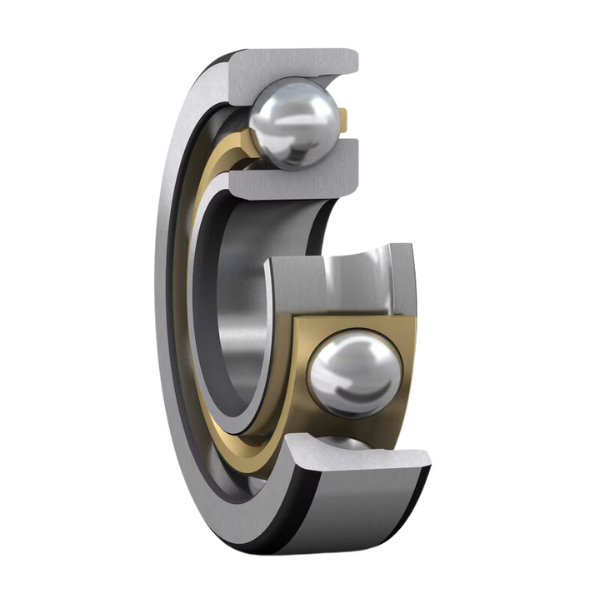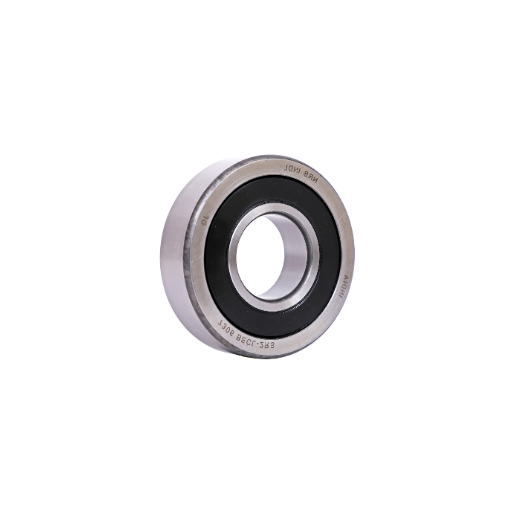Single Row Angular Contact Ball Bearings
Home » Single Row Angular Contact Ball Bearings
-
Understanding Angular Contact Ball Bearings Single Row
AMIGO’s Single Row Angular Contact Ball Bearings are high quality and have high-speed applications at top levels of precision. Both radial and axial load-carrying capabilities would enable these bearings to be employed even in severe conditions like automobiles, aerospace, and industrial equipment. One benefit of selecting AMIGO is that the single-row angular contact ball bearings can be superseded by those of other top brands like SKF, FAG, and NSK. The Company; AMIGO, manufactures bearings of the highest quality, which are fully interchangeable with the bearings manufactured by the best manufacturers in the industry.

Features and benefits
- High load restraints lifting capacity: The lower shoulder of the bearing is constructed so that numerous balls can be housed in it, leading to a rather high load-carrying capability.
- Excellent running capabilities: This design allows for quick increases and decreases in speed, which helps improve the device's running abilities.
- Easy mounting of fit-all bearings: These bearings can be fitted without adjusting the internal clearance/preload.
Temperature Limits
The permissible operating temperature for angular contact ball bearings can be limited by:
- Dimensional stability of the bearing rings and balls
- Cage
- Seals
- Lubricant
The bearings are heat stabilized up to at least 150 °C (300 °F).
Applications
- Automotive Industry: Used in car wheel hubs, transmissions, and steering systems to handle both radial and axial loads, ensuring smooth operation.
- Aerospace Industry: Integral in aircraft engine components and landing gear systems where high precision and durability are essential.
- Industrial Machinery: Employed in machine tool spindles, robotics, and automation systems to handle combined loads with high accuracy.
Single Row Angular Contact Ball Bearing Size Chart
| Designation | Principal dimensions | Bearing Dimensions Chart Pdf | ||
|---|---|---|---|---|
| d[mm] | D[mm] | B[mm] | ||
| 7202b bearing | 15 | 35 | 11 | Download |
| 7309 bearing | 45 | 100 | 25 | Download |
| 7310 bearing | 50 | 110 | 27 | Download |
| 7322b bearing | 110 | 240 | 50 | Download |
| 7211 | 55 | 100 | 21 | Download |
| 7314 | 70 | 150 | 35 | Download |
| 7222 | 110 | 200 | 38 | Download |
| 7317 | 85 | 180 | 41 | Download |
| 7014C | 70 | 110 | 20 | Download |
| 7028 | 140 | 210 | 33 | Download |
Customize bearings to meet your specific needs
Looking for bearings tailored to your unique specifications? Our customization service ensures that each bearing is designed and manufactured to meet your exact requirements, providing the perfect solution for your application. Click the "Enquire Now" button to discuss your needs with our experts and get started on your custom bearing solution today.
Single Row Angular Contact Ball Bearings - Designs and Variants
The standard assortment of single row angular contact ball bearings includes:
Bearings in the 72 B(E) and 73 B(E) series with 40° contact angle
sealed bearings:
- in series 72 B(E) (15 ≤ d ≤ 55 mm)
- in series 73 B(E) (12 ≤ d ≤ 50 mm)
- bearings in the 72 AC series with 25° contact angle (15 ≤ d ≤ 70 mm)
- bearings in the 73 AC series with 25° contact angle (17 ≤ d ≤ 70 mm)
Single Row Angular Contact Ball Bearings Loads
Equivalent Bearing Loads
The Equivalent Dynamic Bearing Load is critical for evaluating the bearing's performance under dynamic conditions.The Equivalent Static Bearing Load is used to assess the bearing's ability to withstand static loads, particularly when the machine is stationary or moving at low speeds.
Minimum Load
To ensure optimal performance and prevent damage, cylindrical roller bearings must operate under a minimum load. The Minimum Load requirement varies depending on whether the bearings are single or arranged in pairs.
Calculating The Axial Load For Bearings Mounted Singly Or Paired In Tandem
When a radial load is applied to a single row angular contact ball bearing, radial loads are also transmitted form one raceway to the other and it leads to internal axial load generation. When it comes to the adjustment of two single bearings and bearing pairs one behind the other, these points must be taken into consideration for the equivalent bear loads calculation.
Load Carrying Capacity Of Bearing Pairs
The values for basic load ratings and fatigue load limits listed in the product table apply to single bearings. For universally matchable bearings mounted immediately adjacent to each other, the following values apply:
- basic dynamic load rating for standard bearings in all arrangements and for AMIGO Explorer bearings in a back-to-back or face-to-face arrangement:
Cpair = 1.62 Csingle bearing - basic dynamic load rating for AMIGO Explorer bearings in a tandem arrangement:Cpair = 2 Csingle bearing
- basic static load rating:
C0 pair = 2 C0single bearing - fatigue load limit:
Pu pair = 2 Pu single bearing
Designation System for Single Row Angular Contact Ball Bearing
Single row cylindrical roller bearings are identified by specific codes that describe their design and features. These designation codes include prefixes, basic designations, and suffixes that provide information on bearing series, bore size, and special features.
| Category | Code | Description |
|---|---|---|
| Basic designation | ALS | Inch bearing |
| AMS | Inch bearing | |
| 22 | /8 = 2 3/4 in. (69,85 mm) bore diameter | |
| to | ||
| 40 | /8 = 5 in. (127 mm) bore diameter | |
| E | Optimized internal design | |
| Suffixes - External design (seals, snap ring groove, execution, etc.) | N1 | One locating slot (notch) in one outer ring side face |
| CA | Bearing for universal matching. Two bearings arranged back-to-back or face-to-face have axial internal clearance smaller than Normal (CB). | |
| CB | Bearing for universal matching. Two bearings arranged back-to-back or face-to-face have Normal axial internal clearance. | |
| CC | Bearing for universal matching. Two bearings arranged back-to-back or face-to-face have axial internal clearance greater than Normal (CB). | |
| G | Bearing for universal matching. Two bearings arranged back-to-back or face-to-face have axial internal clearance. | |
| GA | Bearing for universal matching. Two bearings arranged back-to-back or face-to-face have light preload. | |
| GB | Bearing for universal matching. Two bearings arranged back-to-back or face-to-face have moderate preload. | |
| GC | Bearing for universal matching. Two bearings arranged back-to-back or face-to-face have heavy preload. | |
| -2RZ | Non-contact seal, NBR, on both sides | |
| Suffixes - Cage design | F | Machined steel cage, ball centred |
| J | Stamped steel cage, ball centred | |
| M | Machined brass cage, ball centred; different designs are identified by a number following the M, e.g. M2 | |
| MB | Machined brass cage, inner ring centred | |
| P | Glass fibre reinforced PA66 cage, ball centred | |
| PH | Glass fibre reinforced PEEK cage, ball centred | |
| Y | Stamped brass cage, ball centred | |
| Suffixes - Accuracy, clearance, preload, quiet running | P5 | Dimensional and geometrical tolerances (tolerances of run-out and orientation) to class P5 |
| P6 | Dimensional and geometrical tolerances (tolerances of run-out) to class P6 | |
| Suffixes - Bearing sets, matched bearings | DB | Two bearings matched for mounting back-to-back |
| DF | Two bearings matched for mounting face-to-face | |
| DT | Two bearings matched for mounting in tandem |

Single Row Angular Contact Ball Bearings Catalogue
PDF guide engagement is encouraged by getting the single-row angular contact ball-bearing catalog PDF. This PDF contains information on these high-quality bearings’ features, advantages, and uses, making it valuable for specialists from diverse fields. This PDF will help you with information regarding the compatibility and interchangeability with other brands, making the work easier for you. Download now and see the complete content to get the bearing you want and require.
General bearing specifications
| Specification | Details |
|---|---|
| Dimension standards | Boundary dimensions: ISO 15 and ISO 12044 |
| Tolerances | P6 dimensional tolerance |
| P5 run-out | |
| Values | ISO492 |
| Internal clearance | CA - smaller than Normal axial clearance |
| CB - Normal axial clearance | |
| CC - larger than Normal axial clearance | |
| G (standard for larger bearings) - Normal axial clearance | |
| Preload | GA - light preload (standard) |
| GB - moderate preload | |
| GC - heavy preload | |
| Friction (starting torque, power loss) | Use |
| Defect frequencies | Use |
| Specification | Details |
|---|---|
| Dimension standards | Boundary dimensions: Standard BS 292:Part 2, withdrawn in 1997 |
| Values | BS 292 |
| Internal clearance | Obtained after mounting, depending on adjustment against a second bearing. |
| Preload | Obtained after mounting, depending on adjustment against a second bearing. |
| Permissible misalignment | Misalignment increases bearing noise and reduces bearing service life. |
| Friction (starting torque, power loss) | Use |
| Defect frequencies | Use |
Explore More on Bearings


Frequently Asked Question
Q: What are Single Row Full Complement Cylindrical Roller Bearings?
A: These roller-bearing cylindrical types have no cage and use all the available rollers for maximum radial load capability.
Q: What are the main benefits of Single Row, Full Complement Cylindrical Roller Bearings?
A: They have increased radial load carrying capacity, relatively swept volume, and higher robustness, even in construction, which allows them to cater to heavy-duty applications.
Q: In what industries do Full Complement Cylindrical Roller Bearings operate?
A: They are used in various industries, including heavy machinery, automotive, steel processing, mining, and wind energy.
Q: How are Single-row full-complement cylindrical Roller Bearings distinct from the ordinary cylindrical roller bearings?
A: This type of bearing is a little different from standard bearings in that it does not have a cage. This allows for more rollers in the bearing, hence increasing load capacity, although speed may be a problem.
Q: Is it possible for Single Row Full Complement Cylindrical Roller Bearings to support axial loads?
A: These bearings can be used mainly for radial loads but can support restricted axial loads also in some setups.
Q: What are the usual limits for the speed for Single Row Full Complement Cylindrical Roller Bearings?
A: Since there is no cage in the bearing structure, these bearings are geared towards low—to moderate-speed operation and are more commonly used in high-load systems.
Q: Are Single Row Full Complement Cylindrical Roller Bearings suitable for substituting other radial types of bearings?
A: Yes, they are often replaced with other similar bearing types from reputed manufacturers, provided they are of similar size and have the same load capacity.
Q: What is the effective maintenance of the Single Row Full Complement Cylindrical Roller Bearings?
A: Adequate lubrication and regular checks are necessary to comply with operational requirements and enhance bearing life although application of excessive loads may be detrimental.
Q: What considerations must be considered when choosing Single Row Full Complement Cylindrical Roller Bearings?
A: The load conditions, working speed, space limitations, lubrication method, and application’s operational conditions should be considered.
Q: What are the hazards of operating with a Single Row Full Complement Cylindrical Roller Bearings?
A: These include control of heat when high speeds are attained, proper lubrication, and shielding against dirt in inappropriate conditions.


